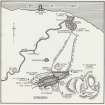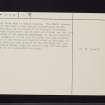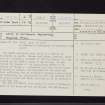Edinburgh, Leith, St Anthony's Preceptory
Friary (Medieval), Hospital (Period Unassigned)
Site Name Edinburgh, Leith, St Anthony's Preceptory
Classification Friary (Medieval), Hospital (Period Unassigned)
Alternative Name(s) Augustinian House Of St Anthony; Friary Of St Anthony At Leith
Canmore ID 51984
Site Number NT27NE 6
NGR NT 2698 7604
Datum OSGB36 - NGR
Permalink http://canmore.org.uk/site/51984
- Council Edinburgh, City Of
- Parish Edinburgh (Edinburgh, City Of)
- Former Region Lothian
- Former District City Of Edinburgh
- Former County Midlothian
NT27NE 6 2698 7604.
(Name: NT 2698 7604) Site of (NAT)
St Anthony's Preceptory or Monastery (NR) (1435)
OS 6" map, Edinburghshire, 1st ed., (1853)
The RCAHMS (1951) and Smith (1930) both refer to a Friary of St Anthony at Leith. Easson (1957) and Cowan (1964), however, refer only to a hospital, founded in 1418 by James I on land granted by Sir Robert Logan of Restalrig. It was erected for canons of the Augustinian order of St Anthony of Vienne - a preceptor and four canons being mentioned in 1443-4, and designed for the poor and those suffering from St Anthony's disease (erysipelas). The preceptory was suppressed in 1591 and granted with the place, lands and other possessions of St Anthony's to Mr John Hay.
The ONB and RCAHMS, both guided by local informants, agree on the sites of the buildings, the ONB stating that there were no extant remains. The RCAHMS, however, were told that a long vaulted subterranean cellar, underlying the warehouse of St Anthony's Clayworks facing Giles Street and St Anthony's Place, was the last vestige of the domestic buildings. It was not possible to examine it as the time of visit, but they consider that if the church and hospital stood as reported, in the positions now occupied by the Trafalgar Hall and Kirkgate Church, then the cellar could not have been part of the associated buildings.
J Smith 1930; RCAHMS 1951; D E Easson 1957; I B Cowan 1957.
Publication Account (1951)
222. The Friary of St. Anthony, 7 St. Anthony Lane.
While it is certain that no part of the house of Austin Friars that existed in 1418 (1) now remains above ground, a long, vaulted subterranean cellar, which underlies the warehouse of St. Anthony's Clayworks, facing Giles Street and St. Anthony's Place, is said locally to be the last vestige of the Friars' domestic buildings. As the cellar is used as a store and was completely filled with boxes at the date of visit no useful examination could be made; but if the Friary church and hospital stood as is reported, in the positions now occupied by the Trafalgar Hall and Kirkgate Church (2), the cellar in question can hardly have been part of that establishment. For "Notes on the Augustinian House of Saint Anthony, Leith," see P.S.A.S., lxiv (1929-30),pp. 275-90.
RCAHMS 1951, visited c.1941
(1) Scottish Supplications to Rome, S.H.S., p. 12. (2) Russell, The Story of Leith, p. 105.
Publication Account (1981)
On the east side of the Kirkgate stood a preceptory for the canons of St.Anthony at Vienne - the only one of its kind in Scotland - which may have been founded by Sir Robert Logan of Restalrig about 1430 (Grant, 1882, iii, 215).
Information from ‘Historic Edinburgh, Canongate and Leith: The Archaeological Implications of Development’ (1981).












